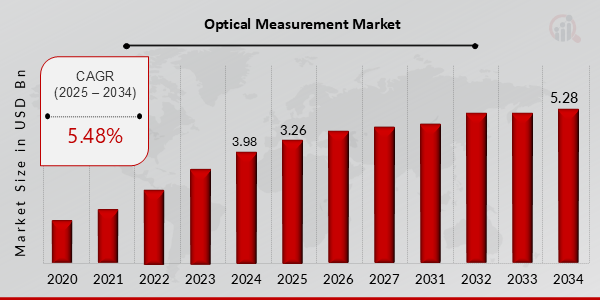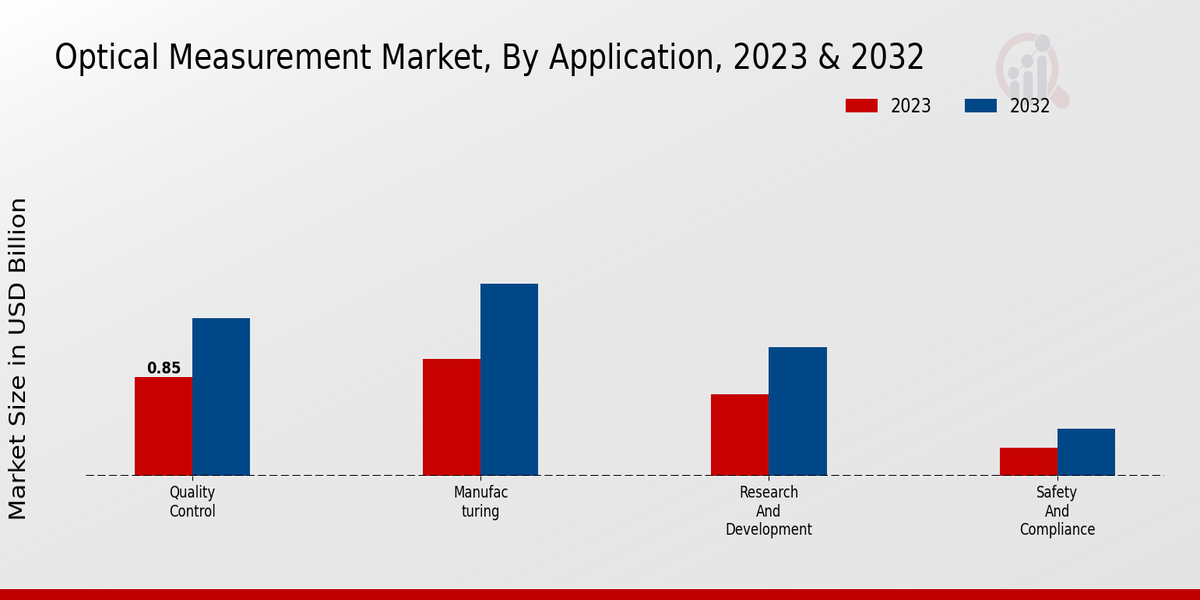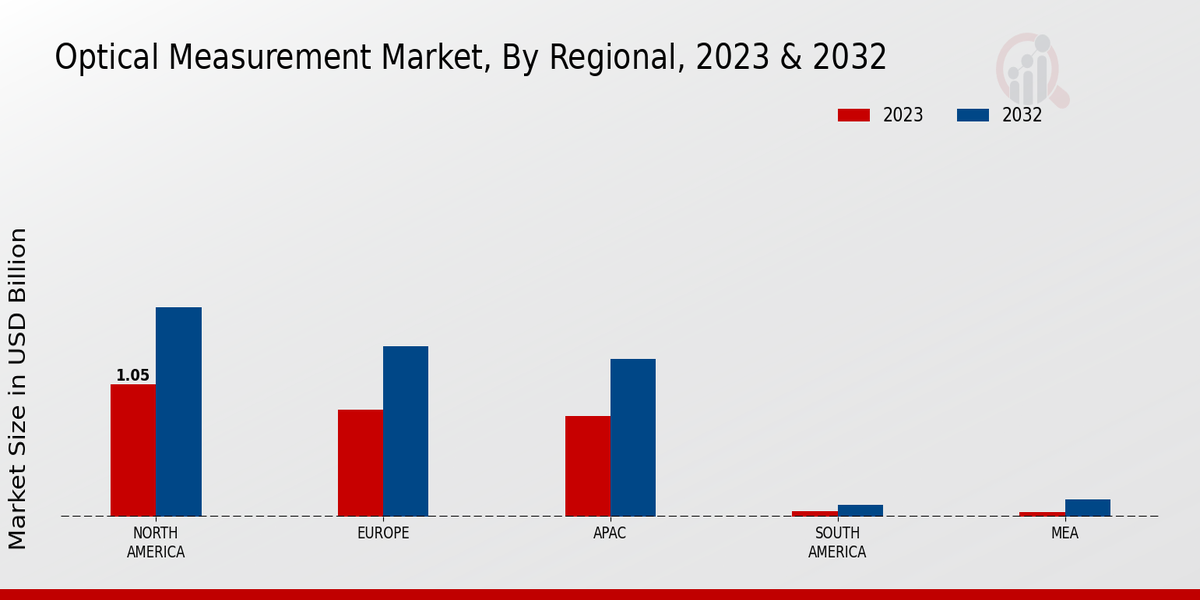Global Optical Measurement Market Overview
Optical Measurement Market Size was estimated at 3.98 (USD Billion) in 2024. The Optical Measurement Market Industry is expected to grow from 3.26 (USD Billion) in 2025 to 5.28 (USD Billion) till 2034, exhibiting a compound annual growth rate (CAGR) of 5.48% during the forecast period (2025 - 2034).
Key Optical Measurement Market Trends Highlighted
The Optical Measurement Market is influenced by several key drivers that support its growth. The increasing demand for high precision in manufacturing processes fuels the need for advanced optical measurement technologies. Industries such as automotive, aerospace, and electronics are adopting these technologies to ensure quality control and enhance operational efficiency. Additionally, the rise in automation and Industry 4.0 initiatives is pushing manufacturers to integrate optical measurement tools into their production lines, allowing for real-time monitoring and data collection. Opportunities within the market are expanding as new applications emerge. The trend toward miniaturization in electronics has created a need for more advanced measurement solutions that can provide accurate data at a smaller scale. Companies are exploring innovative solutions, such as 3D optical measurement, which is gaining traction in various sectors due to its ability to capture complex geometries with speed and precision. Furthermore, the growing emphasis on sustainability and reducing waste presents an opportunity to develop optical measurement systems that can contribute to efficient resource management. In recent times, a notable trend has been the emergence of portable and user-friendly measurement devices. Advancements in sensor technology and imaging have made it possible for users to conduct high-quality measurements in diverse environments. The increased focus on remote capabilities, driven by the pandemic, has also led to the growing adoption of cloud-based optical measurement solutions. This allows for greater collaboration and data sharing among teams, enhancing decision-making processes. The integration of artificial intelligence and machine learning into optical measurement devices is another trend that is shaping the future of the market, helping users interpret data more effectively and making measurement systems smarter and more efficient.

Source: Primary Research, Secondary Research, MRFR Database and Analyst Review
Optical Measurement Market Drivers
Increasing Demand for Precision Measurement in Various Industries
The Optical Measurement Market Industry is witnessing significant growth due to the increasing demand for precision measurement across various industries, including manufacturing, automotive, aerospace and healthcare. As industries continue to evolve and advance technologically, the need for accurate and reliable measurement tools has become more critical. Industries are emphasizing quality control and assurance, requiring sophisticated optical measurement solutions to ensure that products meet specified tolerances and standards. This trend is further driven by the integration of optical measurement systems into automated production lines, improving efficiency while reducing human error. The rising complexity of product designs, from micro-scale components in electronics to intricate parts in aerospace, also compels firms to adopt advanced optical measurement technologies, leading to significant investments in this market segment. Moreover, with the growing focus on research and development, organizations are seeking state-of-the-art optical measurement techniques to innovate and maintain a competitive edge. The synergy between these factors is anticipated to bolster the optical measurement market, paving the way for further technological advancements in the years ahead.
Advancements in Optical Measurement Technology
Technological advancements play a pivotal role in driving the Optical Measurement Market Industry forward. New innovations such as laser scanning, 3D imaging, and high-speed cameras are enhancing measurement accuracy and efficiency. These technologies not only facilitate more sophisticated analysis but also enable real-time monitoring and feedback, which are essential in environments demanding rapid decision-making and process adjustments. As research institutions and manufacturing units strive for improved capabilities, the integration of cutting-edge optical measurement systems into their operations becomes crucial in maintaining their competitive advantage. The constant evolution of technology is thus a key enabler for growth in the optical measurement market.
Rising Importance of Quality Control and Compliance
The escalating importance placed on quality control and regulatory compliance across industries significantly drives the Optical Measurement Market Industry. Companies are increasingly focusing on developing high-quality products that meet stringent safety and quality standards, which necessitates the adoption of optical measurement solutions. As businesses face mounting pressure to comply with regulations, the need for precise and reliable measurement tools becomes paramount, propelling the growth of the optical measurement market forward.
Optical Measurement Market Segment Insights:
Optical Measurement Market Application Insights
The Application segment of the Optical Measurement Market holds significant value, with a valuation of 2.79 USD Billion in 2023 and projected growth over the years. The leading area within this segment is Manufacturing, valued at 1.0 USD Billion in 2023, which dominates due to the increasing demand for precise measurements in production processes that enhance efficiency and reduce waste. Following closely, the Quality Control sector is valued at 0.85 USD Billion, underpinning its importance in maintaining product standards and ensuring adherence to safety regulations, which is crucial as industries push for higher quality outputs. The Research and Development area, valued at 0.7 USD Billion, plays an essential role as it fosters innovation and technological advancements, supporting industries in developing new products. Lastly, Safety and Compliance is valued at 0.24 USD Billion, which, while smaller, remains significant due to the growing emphasis on regulatory standards that require accurate optical measurements to ensure safety and compliance in various sectors. Together, these areas reflect the diverse applications of optical measurement technology, demonstrating how essential this market segment is to overall industry standards and operational effectiveness. The Optical Measurement Market statistics highlight a robust framework for growth, with emerging trends such as automation and digitization in various industries paving the way for further advancements in optical measurement technologies. The market growth is propelled by a rising focus on precision in manufacturing processes, coupled with an increasing need for compliance with stringent safety regulations. These driving factors illustrate the critical role that each application plays within the larger context of the Optical Measurement Market revenue, emphasizing the sector’s varied and profound impact on diverse industries.

Source: Primary Research, Secondary Research, MRFR Database and Analyst Review
Optical Measurement Market Product Type Insights
Spectrometers are widely used for their ability to analyze light and materials, often holding a major share in revenue due to their diverse applications in industries such as pharmaceuticals and environmental monitoring. Interferometers play a crucial role in precise measurements and surface analysis, making them integral to sectors like aerospace and manufacturing. Metrology Systems ensure accuracy and reliability in measurement processes, which is vital for product quality assurance. Optical Sensors, known for their ability to detect and measure physical phenomena, dominate the market due to their extensive use in automation and smart technology applications. The trends impacting this segment include the rising demand for high-precision instruments and advancements in technology, which collectively drive the growth of the Optical Measurement Market. However, challenges such as high initial costs and the complexity of instruments may impact market penetration. Overall, the market segmentation highlights the importance of each product type, shaping the landscape of the optical measurement industry.
Optical Measurement Market End Use Industry Insights
The market segmentation encompasses key sectors such as aerospace, automotive, electronics and healthcare, each driving the demand for advanced optical measurement technologies. The aerospace industry benefits from precise measurements to enhance aircraft safety and performance, while the automotive sector emphasizes quality control and automation in manufacturing processes, leveraging optical measurement for better efficiency.
In electronics, the need for miniaturization and precision in components propels the adoption of optical systems. Healthcare also plays a crucial role in utilizing optical measurement for diagnostics and imaging technologies. Together, these sectors contribute to the overall market dynamics, with the Optical Measurement Market data reflecting a broader trend toward automation and technological advancement across industries, highlighting its importance in maintaining competitive advantages. As growth drivers such as emerging technologies and increasing consumer demands continue to thrive, stakeholders must remain vigilant of challenges such as regulatory requirements and cost management in this evolving landscape.
Optical Measurement Market Technology Insights
Key areas such as Laser-Based Measurement are important due to their ability to offer high accuracy in dimension measurement for various applications, making them a preferred choice among industries. Image Processing also plays a significant role by enabling advanced image analysis, thereby enhancing the capability to inspect and ensure quality control in manufacturing processes.Furthermore, Optical Coherence Tomography is vital in fields like medical imaging, providing detailed images of tissue structures. The combination of these technologies is reshaping the landscape of the Optical Measurement Market, contributing to its growth trajectory. Emerging trends such as integration with AI and digitalization further signify opportunities for innovation, although challenges related to high costs and technological complexity remain prevalent.
Optical Measurement Market Regional Insights
North America holds the majority share, valued at 1.05 USD Billion, which is expected to rise to 1.66 USD Billion by 2032. This region's dominance is supported by a strong demand for advanced measurement technologies in various industries. Europe follows closely, beginning at 0.85 USD Billion in 2023 and anticipated to reach 1.35 USD Billion by 2032, reflecting its importance in manufacturing and quality control applications.The Asia-Pacific region, valued at 0.8 USD Billion in 2023, is anticipated to grow to 1.25 USD Billion, indicating a growing adoption of optical measurement systems driven by industrial expansion. South America, starting at 0.05 USD Billion, and the MEA region, at 0.04 USD Billion, represent the smaller segments of the Optical Measurement Market, but with expected growth to 0.1 USD Billion and 0.14 USD Billion, respectively, they present emerging opportunities for technology advancement and market entry in these regions. Thus, the optimization and advancement in measurement technology play a pivotal role in shaping the trends and developments in the Optical Measurement Market statistics.

Source: Primary Research, Secondary Research, MRFR Database and Analyst Review
Optical Measurement Market Key Players and Competitive Insights:
The Optical Measurement Market has been experiencing substantial growth, driven by advancements in measurement technologies and an increasing demand for high precision in various industries. As the market becomes more competitive, various players are constantly innovating their offerings to maintain and enhance their market presence. The competitive landscape is characterized by a blend of established companies and emerging players, each vying for a greater share through strategic partnerships, technological advancements and superior product offerings. Companies are not only competing on the basis of pricing but also on the quality of their optical measurement solutions, which are crucial for applications in industries such as automotive, aerospace, electronics and healthcare. With the evolving market dynamics, businesses are required to adapt quickly to changing customer demands and technological advancements, making it imperative for them to continuously invest in research and development to stay ahead.Carl Zeiss AG holds a significant position in the Optical Measurement Market, known for its innovative solutions and high-quality optical instruments. The company's long-standing reputation for excellence is built upon its commitment to precision and accuracy in measurements, which are paramount in fields such as microscopy and industrial metrology. Carl Zeiss AG leverages its extensive experience and expertise in optics to deliver cutting-edge measurement technologies that meet stringent industry standards. The company has a robust global presence, offering a diverse range of products that cater to various industrial needs. With strong brand equity and a commitment to continuous improvement, Carl Zeiss AG stands out in the market, providing comprehensive solutions that empower industries to enhance their operational efficiencies.Olympus Corporation is another key player in the Optical Measurement Market, renowned for its advanced imaging and measurement technologies. The company has made substantial strides in defining industry standards through its innovative optical solutions tailored to meet the diverse measurement requirements in sectors such as manufacturing, electronics, and quality control. Olympus Corporation focuses on providing versatile and user-friendly optical measurement tools that enhance productivity and accuracy. The company has a dedicated approach to customer engagement, ensuring that its products are aligned with the evolving needs of the industry while maintaining high levels of reliability and performance. By integrating groundbreaking technology with practical application, Olympus Corporation reinforces its position in the market and continues to be a preferred choice for organizations seeking sophisticated optical measurement solutions.
Key Companies in the Optical Measurement Market Include:
- Carl Zeiss AG
- Olympus Corporation
- Hexagon AB
- Mitutoyo Corporation
- Renishaw plc
- FARO Technologies
- Bristol Instruments
- LEICA Geosystems
- Zygo Corporation
- Ametek, Inc.
- KLA Corporation
- Nikon Metrology
- Tesa Technology
- Keyence Corporation
- OptiPro Systems
Optical Measurement Industry Developments
Recent developments in the Optical Measurement Market underscore a dynamic landscape. Companies like Carl Zeiss AG and KLA Corporation are innovating with advanced optical technologies, targeting sectors such as automotive and aerospace. Olympus Corporation has made strides in developing high-precision optical measurement solutions, enhancing quality control processes. Meanwhile, Hexagon AB has expanded its product offerings, focusing on digital transformation and smart manufacturing solutions. Noteworthy is the recent acquisition by Renishaw plc of a smaller firm to bolster its end-to-end optical measurement capabilities, strengthening its position in the market.
Additionally, Nikon Metrology and Keyence Corporation have been actively launching new products that offer better integration of optical measurement systems with existing manufacturing processes, which is gaining traction. With the demand for greater precision and efficiency in manufacturing and quality assurance, the overall market valuation is reportedly on an upward trend, signaling strong growth potential. Companies like FARO Technologies and Zygo Corporation are poised to benefit from increased investments in manufacturing automation and quality inspection technologies, indicating a robust future for the Optical Measurement Market.
Optical Measurement Market Segmentation Insights
Optical Measurement Market Application Outlook
- Quality Control
- Manufacturing
- Research and Development
- Safety and Compliance
Optical Measurement Market Product Type Outlook
- Spectrometers
- Interferometers
- Metrology Systems
- Optical Sensors
Optical Measurement Market End Use Industry Outlook
- Aerospace
- Automotive
- Electronics
- Healthcare
Optical Measurement Market Technology Outlook
- Laser-Based Measurement
- Image Processing
- Optical Coherence Tomography
Optical Measurement Market Regional Outlook
- North America
- Europe
- South America
- Asia Pacific
- Middle East and Africa
|
Report Attribute/Metric
|
Details
|
|
Market Size 2024
|
USD 3.98 Billion
|
|
Market Size 2025
|
USD 3.26 Billion
|
|
Market Size 2034
|
USD 5.28 Billion
|
|
Compound Annual Growth Rate (CAGR)
|
5.48% (2025-2034)
|
|
Base Year
|
2024
|
|
Market Forecast Period
|
2025-2034
|
|
Historical Data
|
2020-2023
|
| Market Forecast Units |
USD Billion |
| Key Companies Profiled |
Carl Zeiss AG, Olympus Corporation, Hexagon AB, Mitutoyo Corporation, Renishaw plc, FARO Technologies, Bristol Instruments, LEICA Geosystems, Zygo Corporation, Ametek, Inc., KLA Corporation, Nikon Metrology, Tesa Technology, Keyence Corporation, OptiPro Systems |
| Segments Covered |
Application, Product Type, End Use Industry, Technology, Regional |
| Key Market Opportunities |
1. Growing demand for quality control, 2. Expansion in healthcare applications, 3. Rising automation in manufacturing, 4. Advancements in sensor technology, 5. Increased investment in research and development |
| Key Market Dynamics |
1. Technological advancements, 2. Increasing industrial automation, 3. Growing demand for quality control, 4. Rising need for precision measurement, 5. Expanding applications in research |
| Countries Covered |
North America, Europe, APAC, South America, MEA |
Frequently Asked Questions (FAQ) :
The Optical Measurement Market is valued at 3.98 USD Billion in 2024.
The market is expected to reach 5.28 USD Billion by 2034.
The expected CAGR for the market is 5.48% from 2025 to 2034.
North America holds the largest market share, valued at 1.05 USD Billion in 2023.
The projected market value for North America is 1.66 USD Billion by 2032.
The Quality Control application segment is valued at 0.85 USD Billion in 2023.
The Manufacturing application segment is expected to reach 1.65 USD Billion by 2032.
Key players in the market include Carl Zeiss AG, Olympus Corporation, and Hexagon AB.
The APAC region is projected to grow from 0.8 USD Billion in 2023 to 1.25 USD Billion by 2032.
Challenges may include technological advancements and regulatory compliance across different regions.

















